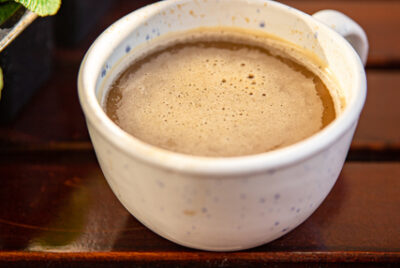What is White Coffee? A Deep Dive into Its Charm
You’ve likely tried countless coffee varieties: from the dark, intense espressos to the creamy lattes. But have you ever stumbled upon the mystique of white coffee? If you’re wondering: “What is white coffee?” prepare to be enlightened.
Origin of White Coffee
White coffee technically has two meanings. The original comes Malaysia and refers to a specific blend. The second kind is the “western” version, and simply refers to black coffee that only has milk or cream added. As the second version is fairly straight forward, we’ll be covering the original version that has its roots from Malaysia.
The Malaysian Connection
White coffee is truly a gem from the Malaysian coffee culture. Hailing specifically from the town of Ipoh in the state of Perak, this unique blend was born out of a combination of cultural influences and innovation. Malaysia, being a melting pot of Chinese, Malay, and Indian cultures, has a rich tradition of culinary experimentation.
In the old streets of Ipoh, traditional coffee shops known as ‘kopitiams’ serve up this aromatic brew alongside other Malaysian culinary delights. These establishments have been the heartbeat of Malaysian social life for decades, with old-timers and youngsters gathering for a cup of ‘kopi putih’ and a chat.
The Name’s Deception
Despite its name, white coffee is not actually white. The term “white” refers to the beans’ unique roasting process and not its color. In Hokkien (a Chinese dialect), the term for ‘without’ or ‘unadulterated’ sounds similar to ‘white’. Thus, the name actually signifies coffee that’s free from the usual heavy caramelization.
Evolution of the Blend
Originally, white coffee was simply made from beans roasted in margarine, resulting in a lighter color and distinct taste. Over the years, as its popularity grew beyond the shores of Malaysia, variations emerged. Today, in many parts of Asia, white coffee often comes premixed with sugar and non-dairy creamer or condensed milk, making it a rich, sweet beverage that stands apart from other brews.
The Spread of White Coffee
The allure of white coffee didn’t just remain confined to Malaysia. As people traveled and trade routes expanded, this unique coffee preparation found its way to neighboring countries like Singapore and Indonesia. Moreover, with the global rise of specialty and artisanal coffee cultures, white coffee has carved a niche for itself among coffee enthusiasts worldwide.
Each sip tells a story of its rich history, of old kopitiams, bustling streets, and the Malaysian spirit of innovation in culinary delights. And as more and more coffee aficionados discover its charms, white coffee continues to solidify its place in the world of gourmet beverages.
The Brewing Process
White coffee, with its distinct characteristics, requires a unique approach to brewing. If you’re new to this type of coffee, understanding its brewing method can make all the difference in capturing its delicate flavors and aroma. Let’s dive deep into the brewing process:
1. Choosing Your Beans:
Source Matters: Since white coffee retains much of its original flavor due to the minimal roasting, it’s essential to choose high-quality beans. Beans that are fresh and sourced from reputable growers will offer a more authentic taste.
2. Grinding the Beans:
Consistency is Key: White coffee beans are harder than their darker roasted counterparts, so you’ll need a robust grinder. Aim for a medium-fine grind, similar to table salt, to extract the best flavor. Click here for a more detailed guide how to grind coffee beans.
3. Water Temperature:
Not Too Hot: Unlike darker roasts, white coffee requires a slightly cooler water temperature. Aim for around 185°F (85°C) to avoid over-extraction, which can make your coffee bitter.
4. Brewing Method:
French Press: Many white coffee aficionados swear by the French press method. This method allows the coffee to steep directly in water, capturing its subtle flavors. To brew, add your ground white coffee to the press, pour in the hot water, and steep for 4-5 minutes before pressing.
AeroPress: Another popular method for white coffee is the AeroPress, which provides a clean and flavorful cup. Use the inverted method, steep for about 2-3 minutes, and then press.
Pour-Over: The pour-over method can also be employed. It offers more control over the pouring and saturation process, ensuring all the coffee grounds are evenly saturated. This method can highlight the nuanced flavors.
5. Serving:
Appreciate the Aroma: Once brewed, take a moment to appreciate the unique aroma of white coffee before pouring it into your cup. Some enthusiasts even prefer to drink it at a slightly cooler temperature to fully experience its range of flavors.
6. Optional Add-ins:
While many purists prefer their white coffee black to appreciate its unique profile, you can always tailor it to your liking. Consider adding a splash of milk or a hint of sweetener. Remember, the flavors of white coffee are subtle, so avoid overpowering it with too many additions.
Taste and Aroma
A Distinct Flavor Profile
The taste of white coffee is truly unique and can be quite different from what most people expect when they hear the term ‘coffee’. Without the heavy caramelization that comes from traditional roasting methods, these beans produce a brew that’s milder, less acidic, and often described as having a creamy, nutty flavor. There’s a subtle sweetness, not from added sugar but from the natural flavors of the coffee bean which shine through more prominently due to the lighter roast.
The Aromatic Experience
There’s no denying the allure of the aroma when a cup of this brew is placed before you. It’s less pungent than darker roasts, but incredibly inviting. The scent is a delicate bouquet of toasted nuts, hints of cocoa, and sometimes, a faint fruity undertone. For many, the aroma itself is a comforting experience, evoking images of serene mornings or relaxed afternoons in a cozy café.
The Creamy Undertones
Often, white coffee is brewed with condensed milk or a non-dairy creamer, which further enhances its creamy texture and taste. This gives it a rich mouthfeel that’s both velvety and smooth. The combination of the light roast coffee with the sweetness of the condensed milk creates a well-balanced taste that’s neither too overpowering nor too mild. It’s just right.
Comparisons with Other Brews
If you’re a fan of lattes or cappuccinos, you might find some similarities in the creamy texture of white coffee, but the taste is distinct. It doesn’t have the robustness of an espresso or the smokiness of a dark roast. Instead, it offers a gentle, nuanced flavor profile that’s perfect for those who enjoy savoring their coffee rather than just drinking it.
Health Benefits
Lower Acidity Levels
One of the most significant advantages of white coffee over its traditionally roasted counterparts is its lower acidity level. Because the beans are roasted for a shorter period and at lower temperatures, the coffee retains its natural pH levels better. This makes it a preferable choice for individuals who suffer from acid reflux or sensitive stomachs, allowing them to enjoy their daily cup without the usual discomfort.
Rich in Antioxidants
This brew undergoes minimal processing, which allows it to preserve many of its natural antioxidants. Antioxidants are vital for combating free radicals in the body, which can lead to oxidative stress and contribute to various health issues. Including this delicious brew in your diet can thus serve as a boost for your body’s defense mechanisms.
Reduced Caffeine Content
While it is not caffeine-free, its caffeine content is usually lower than darker roasts. This can be a boon for those who are trying to limit their caffeine intake but still crave the comfort and ritual of a warm coffee cup. It offers a milder stimulation, reducing the chances of jitters, rapid heartbeat, or disrupted sleep patterns that some people experience with high-caffeine beverages.
Promotes Brain Health
Regular coffee consumption has been linked to a reduced risk of neurodegenerative diseases like Alzheimer’s and Parkinson’s. White coffee, with its unique nutrient composition and antioxidants, can play a role in promoting brain health and cognitive functions.
Potential for Weight Management
The combination of caffeine and essential nutrients in white coffee can help enhance metabolic rate, potentially aiding in weight management. While it’s not a miracle solution, when consumed as a part of a balanced diet and combined with regular exercise, this drink can complement weight loss efforts.
Good for the Liver
Various studies on coffee consumption have shown potential benefits for liver health. All coffee drinkers may have a reduced risk of liver diseases, including cirrhosis and liver cancer.
Mood Enhancer
Like all coffees, this drink can act as a mood enhancer. The caffeine it contains stimulates the production of neurotransmitters like dopamine and serotonin, which can uplift mood, improve focus, and increase motivation.
Popular Preparations
The Rise of Instant Mixes
As white coffee gained popularity, many brands started offering instant mixes, providing a quick fix for those eager to try.
Crafting Your Own at Home
While purists might scoff at the idea, making white coffee at home is quite simple. Use lightly roasted beans, grind them finely, and experiment with brewing times.
What is White Coffee FAQs
Is white coffee really white?
No, it’s not about the color but the roasting and preparation method.
Does it have caffeine?
Yes, it contains caffeine but might have slightly less than darker roasts due to its light roasting process.
Can I make white coffee without the traditional beans?
While the authentic taste comes from specific beans and roasting, you can experiment at home with lighter roasts.
Is it sweeter than regular coffee?
Traditionally, it’s served with condensed milk, which adds sweetness. However, you can adjust the sweetness to your preference.
Where can I buy?
Many specialty coffee shops and online retailers offer white coffee beans or premade mixes.




